University Report: Assistant Practitioner Role Development Analysis
VerifiedAdded on 2022/10/02
|21
|6211
|65
Report
AI Summary
This report delves into the multifaceted role of assistant practitioners in the UK healthcare system. It begins by exploring the factors influencing the development of this role, including the increasing patient numbers, nurse shortages, rising healthcare demands, cost-efficiency, technological advancements, and the need for flexibility and specialization within the health industry. The report then examines the critical importance of communication skills for assistant practitioners, especially in managing patients experiencing distress due to mental, physical, or emotional issues. It discusses both verbal and non-verbal communication techniques, highlighting the significance of active listening, questioning, and empathy in providing effective patient care. The report emphasizes how assistant practitioners can leverage these skills to improve patient outcomes and enhance the overall standard of care within a clinical environment. The report also highlights how the assistant practitioner role addresses the challenges of staffing shortages, increased patient loads, and the need for cost-effective healthcare solutions.
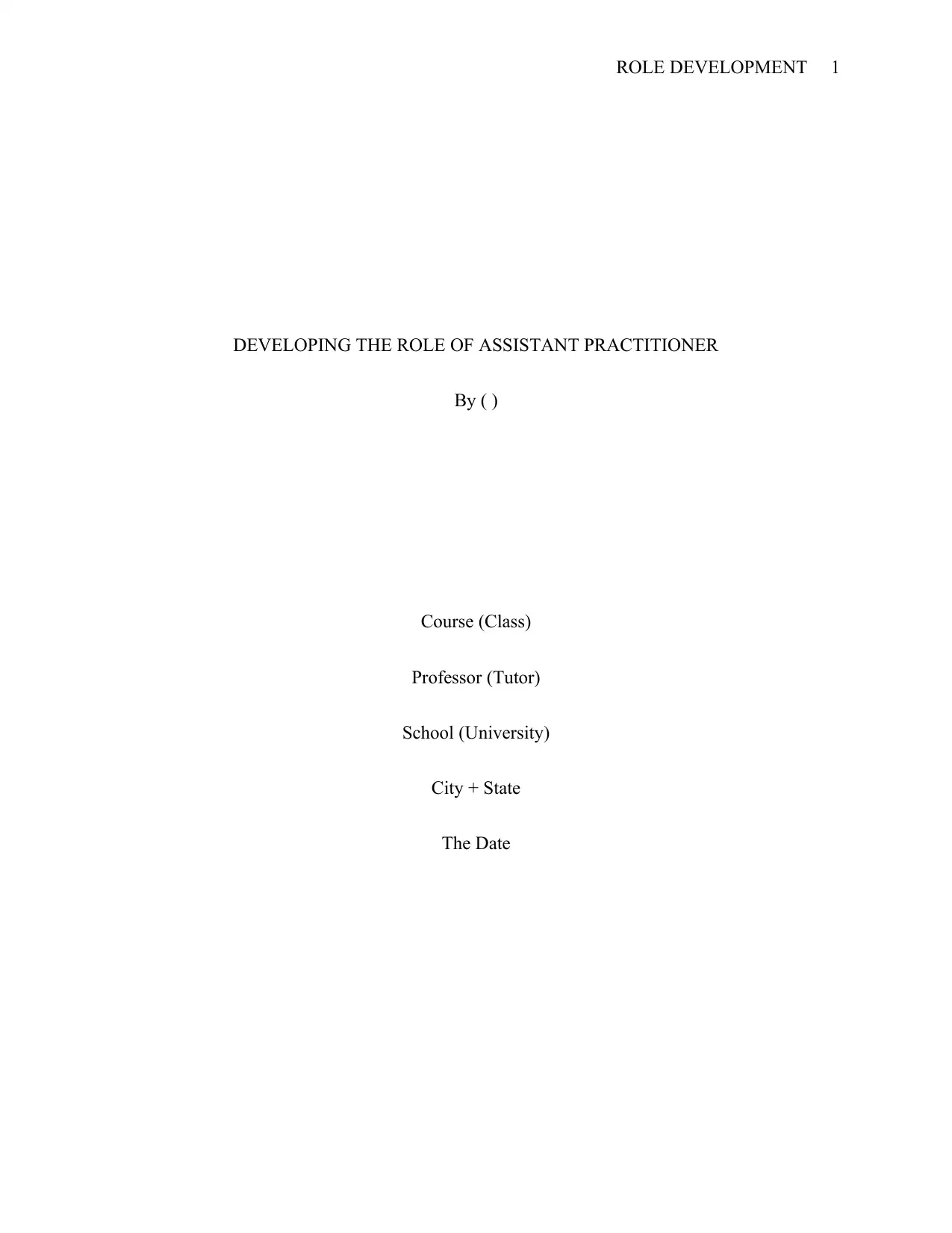
ROLE DEVELOPMENT 1
DEVELOPING THE ROLE OF ASSISTANT PRACTITIONER
By ( )
Course (Class)
Professor (Tutor)
School (University)
City + State
The Date
DEVELOPING THE ROLE OF ASSISTANT PRACTITIONER
By ( )
Course (Class)
Professor (Tutor)
School (University)
City + State
The Date
Paraphrase This Document
Need a fresh take? Get an instant paraphrase of this document with our AI Paraphraser
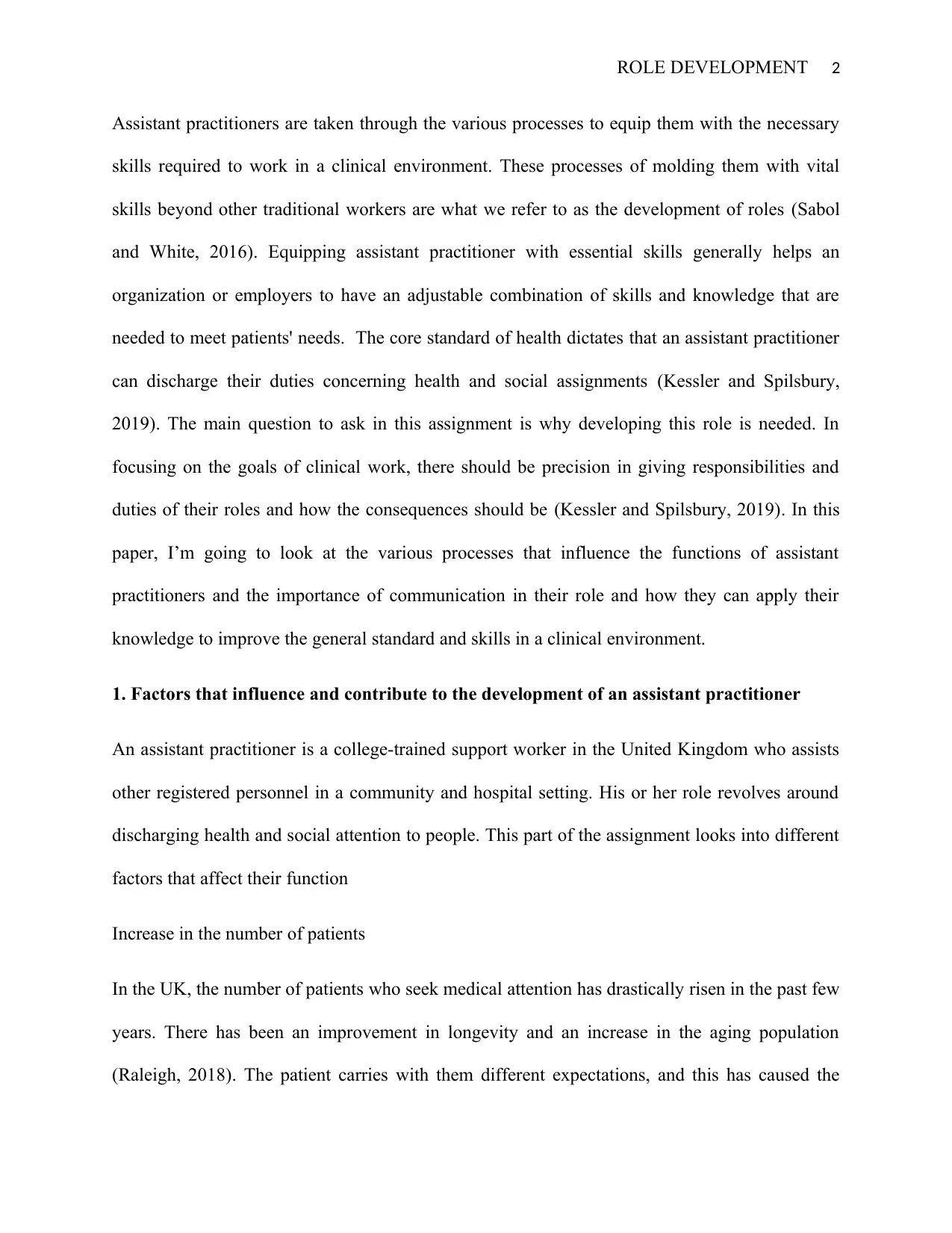
ROLE DEVELOPMENT 2
Assistant practitioners are taken through the various processes to equip them with the necessary
skills required to work in a clinical environment. These processes of molding them with vital
skills beyond other traditional workers are what we refer to as the development of roles (Sabol
and White, 2016). Equipping assistant practitioner with essential skills generally helps an
organization or employers to have an adjustable combination of skills and knowledge that are
needed to meet patients' needs. The core standard of health dictates that an assistant practitioner
can discharge their duties concerning health and social assignments (Kessler and Spilsbury,
2019). The main question to ask in this assignment is why developing this role is needed. In
focusing on the goals of clinical work, there should be precision in giving responsibilities and
duties of their roles and how the consequences should be (Kessler and Spilsbury, 2019). In this
paper, I’m going to look at the various processes that influence the functions of assistant
practitioners and the importance of communication in their role and how they can apply their
knowledge to improve the general standard and skills in a clinical environment.
1. Factors that influence and contribute to the development of an assistant practitioner
An assistant practitioner is a college-trained support worker in the United Kingdom who assists
other registered personnel in a community and hospital setting. His or her role revolves around
discharging health and social attention to people. This part of the assignment looks into different
factors that affect their function
Increase in the number of patients
In the UK, the number of patients who seek medical attention has drastically risen in the past few
years. There has been an improvement in longevity and an increase in the aging population
(Raleigh, 2018). The patient carries with them different expectations, and this has caused the
Assistant practitioners are taken through the various processes to equip them with the necessary
skills required to work in a clinical environment. These processes of molding them with vital
skills beyond other traditional workers are what we refer to as the development of roles (Sabol
and White, 2016). Equipping assistant practitioner with essential skills generally helps an
organization or employers to have an adjustable combination of skills and knowledge that are
needed to meet patients' needs. The core standard of health dictates that an assistant practitioner
can discharge their duties concerning health and social assignments (Kessler and Spilsbury,
2019). The main question to ask in this assignment is why developing this role is needed. In
focusing on the goals of clinical work, there should be precision in giving responsibilities and
duties of their roles and how the consequences should be (Kessler and Spilsbury, 2019). In this
paper, I’m going to look at the various processes that influence the functions of assistant
practitioners and the importance of communication in their role and how they can apply their
knowledge to improve the general standard and skills in a clinical environment.
1. Factors that influence and contribute to the development of an assistant practitioner
An assistant practitioner is a college-trained support worker in the United Kingdom who assists
other registered personnel in a community and hospital setting. His or her role revolves around
discharging health and social attention to people. This part of the assignment looks into different
factors that affect their function
Increase in the number of patients
In the UK, the number of patients who seek medical attention has drastically risen in the past few
years. There has been an improvement in longevity and an increase in the aging population
(Raleigh, 2018). The patient carries with them different expectations, and this has caused the
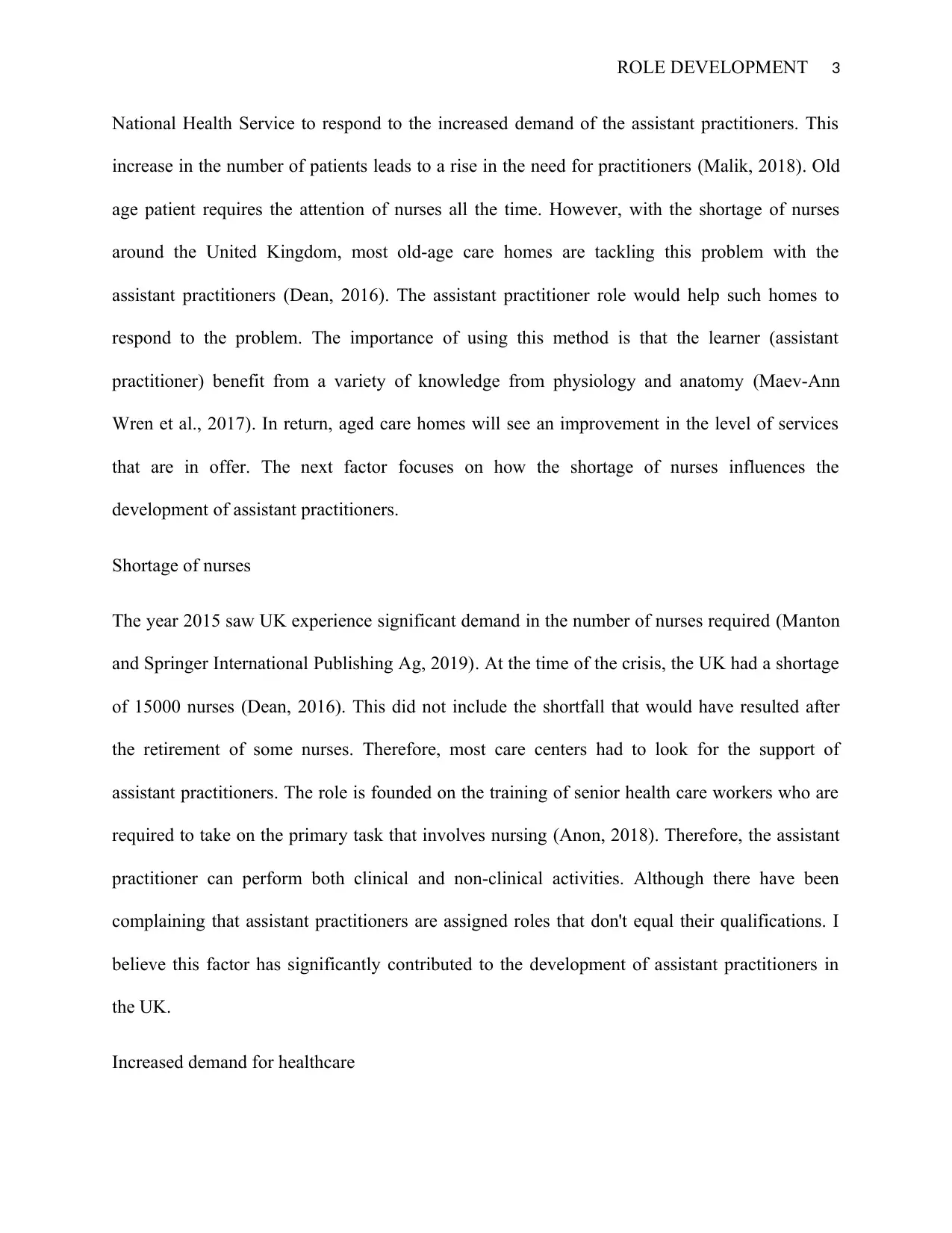
ROLE DEVELOPMENT 3
National Health Service to respond to the increased demand of the assistant practitioners. This
increase in the number of patients leads to a rise in the need for practitioners (Malik, 2018). Old
age patient requires the attention of nurses all the time. However, with the shortage of nurses
around the United Kingdom, most old-age care homes are tackling this problem with the
assistant practitioners (Dean, 2016). The assistant practitioner role would help such homes to
respond to the problem. The importance of using this method is that the learner (assistant
practitioner) benefit from a variety of knowledge from physiology and anatomy (Maev-Ann
Wren et al., 2017). In return, aged care homes will see an improvement in the level of services
that are in offer. The next factor focuses on how the shortage of nurses influences the
development of assistant practitioners.
Shortage of nurses
The year 2015 saw UK experience significant demand in the number of nurses required (Manton
and Springer International Publishing Ag, 2019). At the time of the crisis, the UK had a shortage
of 15000 nurses (Dean, 2016). This did not include the shortfall that would have resulted after
the retirement of some nurses. Therefore, most care centers had to look for the support of
assistant practitioners. The role is founded on the training of senior health care workers who are
required to take on the primary task that involves nursing (Anon, 2018). Therefore, the assistant
practitioner can perform both clinical and non-clinical activities. Although there have been
complaining that assistant practitioners are assigned roles that don't equal their qualifications. I
believe this factor has significantly contributed to the development of assistant practitioners in
the UK.
Increased demand for healthcare
National Health Service to respond to the increased demand of the assistant practitioners. This
increase in the number of patients leads to a rise in the need for practitioners (Malik, 2018). Old
age patient requires the attention of nurses all the time. However, with the shortage of nurses
around the United Kingdom, most old-age care homes are tackling this problem with the
assistant practitioners (Dean, 2016). The assistant practitioner role would help such homes to
respond to the problem. The importance of using this method is that the learner (assistant
practitioner) benefit from a variety of knowledge from physiology and anatomy (Maev-Ann
Wren et al., 2017). In return, aged care homes will see an improvement in the level of services
that are in offer. The next factor focuses on how the shortage of nurses influences the
development of assistant practitioners.
Shortage of nurses
The year 2015 saw UK experience significant demand in the number of nurses required (Manton
and Springer International Publishing Ag, 2019). At the time of the crisis, the UK had a shortage
of 15000 nurses (Dean, 2016). This did not include the shortfall that would have resulted after
the retirement of some nurses. Therefore, most care centers had to look for the support of
assistant practitioners. The role is founded on the training of senior health care workers who are
required to take on the primary task that involves nursing (Anon, 2018). Therefore, the assistant
practitioner can perform both clinical and non-clinical activities. Although there have been
complaining that assistant practitioners are assigned roles that don't equal their qualifications. I
believe this factor has significantly contributed to the development of assistant practitioners in
the UK.
Increased demand for healthcare
⊘ This is a preview!⊘
Do you want full access?
Subscribe today to unlock all pages.

Trusted by 1+ million students worldwide
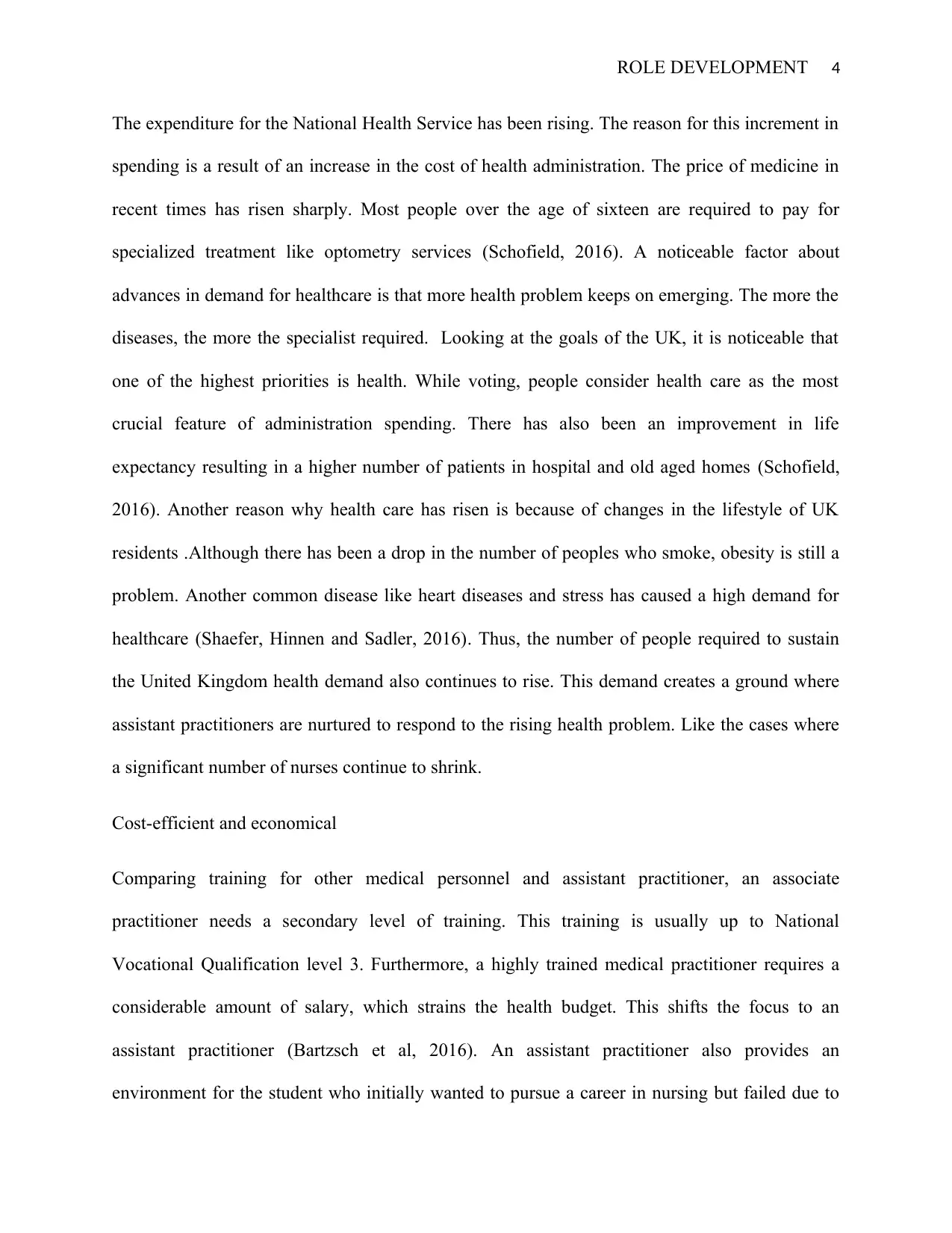
ROLE DEVELOPMENT 4
The expenditure for the National Health Service has been rising. The reason for this increment in
spending is a result of an increase in the cost of health administration. The price of medicine in
recent times has risen sharply. Most people over the age of sixteen are required to pay for
specialized treatment like optometry services (Schofield, 2016). A noticeable factor about
advances in demand for healthcare is that more health problem keeps on emerging. The more the
diseases, the more the specialist required. Looking at the goals of the UK, it is noticeable that
one of the highest priorities is health. While voting, people consider health care as the most
crucial feature of administration spending. There has also been an improvement in life
expectancy resulting in a higher number of patients in hospital and old aged homes (Schofield,
2016). Another reason why health care has risen is because of changes in the lifestyle of UK
residents .Although there has been a drop in the number of peoples who smoke, obesity is still a
problem. Another common disease like heart diseases and stress has caused a high demand for
healthcare (Shaefer, Hinnen and Sadler, 2016). Thus, the number of people required to sustain
the United Kingdom health demand also continues to rise. This demand creates a ground where
assistant practitioners are nurtured to respond to the rising health problem. Like the cases where
a significant number of nurses continue to shrink.
Cost-efficient and economical
Comparing training for other medical personnel and assistant practitioner, an associate
practitioner needs a secondary level of training. This training is usually up to National
Vocational Qualification level 3. Furthermore, a highly trained medical practitioner requires a
considerable amount of salary, which strains the health budget. This shifts the focus to an
assistant practitioner (Bartzsch et al, 2016). An assistant practitioner also provides an
environment for the student who initially wanted to pursue a career in nursing but failed due to
The expenditure for the National Health Service has been rising. The reason for this increment in
spending is a result of an increase in the cost of health administration. The price of medicine in
recent times has risen sharply. Most people over the age of sixteen are required to pay for
specialized treatment like optometry services (Schofield, 2016). A noticeable factor about
advances in demand for healthcare is that more health problem keeps on emerging. The more the
diseases, the more the specialist required. Looking at the goals of the UK, it is noticeable that
one of the highest priorities is health. While voting, people consider health care as the most
crucial feature of administration spending. There has also been an improvement in life
expectancy resulting in a higher number of patients in hospital and old aged homes (Schofield,
2016). Another reason why health care has risen is because of changes in the lifestyle of UK
residents .Although there has been a drop in the number of peoples who smoke, obesity is still a
problem. Another common disease like heart diseases and stress has caused a high demand for
healthcare (Shaefer, Hinnen and Sadler, 2016). Thus, the number of people required to sustain
the United Kingdom health demand also continues to rise. This demand creates a ground where
assistant practitioners are nurtured to respond to the rising health problem. Like the cases where
a significant number of nurses continue to shrink.
Cost-efficient and economical
Comparing training for other medical personnel and assistant practitioner, an associate
practitioner needs a secondary level of training. This training is usually up to National
Vocational Qualification level 3. Furthermore, a highly trained medical practitioner requires a
considerable amount of salary, which strains the health budget. This shifts the focus to an
assistant practitioner (Bartzsch et al, 2016). An assistant practitioner also provides an
environment for the student who initially wanted to pursue a career in nursing but failed due to
Paraphrase This Document
Need a fresh take? Get an instant paraphrase of this document with our AI Paraphraser

ROLE DEVELOPMENT 5
financial factors. Thus, being an associate practitioner would bring such a person closer to
his/her dream.
Technology
The UK health sector has seen significant development in the equipment used for treatment.
There has been an introduction of magnetic resonance imaging (MRI) and computed tomography
(CT) for the past few decades (Ibrahim and Zerhouni, 2017). Therefore, this creates development
in need of the assistant practitioner. The field of operation of the associate practitioner involves
team assistant in diabetes and occupational therapy (Bartzsch et al., 2016). The specialized area
that consists of the use of technological equipment is radiography, especially for patients with
cancer. Other areas include nuclear medicine, mammography, and diagnostic radiography.
Radiography is an area that has contributed significantly to the rise of assistant practitioners
(Fuller, 2019). The sophistication that surrounds the use of X-ray methods leads to increased
demand for radiographers who possess added skills and techniques like the use of intravenous
injection (Bartzsch et al., 2016). There is a need for a large number of radiographers who can
perform such services like imaging. This demand has seen many assistant practitioners in many
imaging sections. However, they're mostly under the supervision of radiographers and other
specialists in their respective fields.
Flexibility and capacity
The subject of capacity and flexibility highlights the matter of staffing and the vast call for
medical services. The reason why assistants practitioner are flexible and capacitated is that they
help in undertaking more straightforward functions, which in return, allowing treatment of an
increasing number of patients (Stewart and Denisco, 2015).
financial factors. Thus, being an associate practitioner would bring such a person closer to
his/her dream.
Technology
The UK health sector has seen significant development in the equipment used for treatment.
There has been an introduction of magnetic resonance imaging (MRI) and computed tomography
(CT) for the past few decades (Ibrahim and Zerhouni, 2017). Therefore, this creates development
in need of the assistant practitioner. The field of operation of the associate practitioner involves
team assistant in diabetes and occupational therapy (Bartzsch et al., 2016). The specialized area
that consists of the use of technological equipment is radiography, especially for patients with
cancer. Other areas include nuclear medicine, mammography, and diagnostic radiography.
Radiography is an area that has contributed significantly to the rise of assistant practitioners
(Fuller, 2019). The sophistication that surrounds the use of X-ray methods leads to increased
demand for radiographers who possess added skills and techniques like the use of intravenous
injection (Bartzsch et al., 2016). There is a need for a large number of radiographers who can
perform such services like imaging. This demand has seen many assistant practitioners in many
imaging sections. However, they're mostly under the supervision of radiographers and other
specialists in their respective fields.
Flexibility and capacity
The subject of capacity and flexibility highlights the matter of staffing and the vast call for
medical services. The reason why assistants practitioner are flexible and capacitated is that they
help in undertaking more straightforward functions, which in return, allowing treatment of an
increasing number of patients (Stewart and Denisco, 2015).
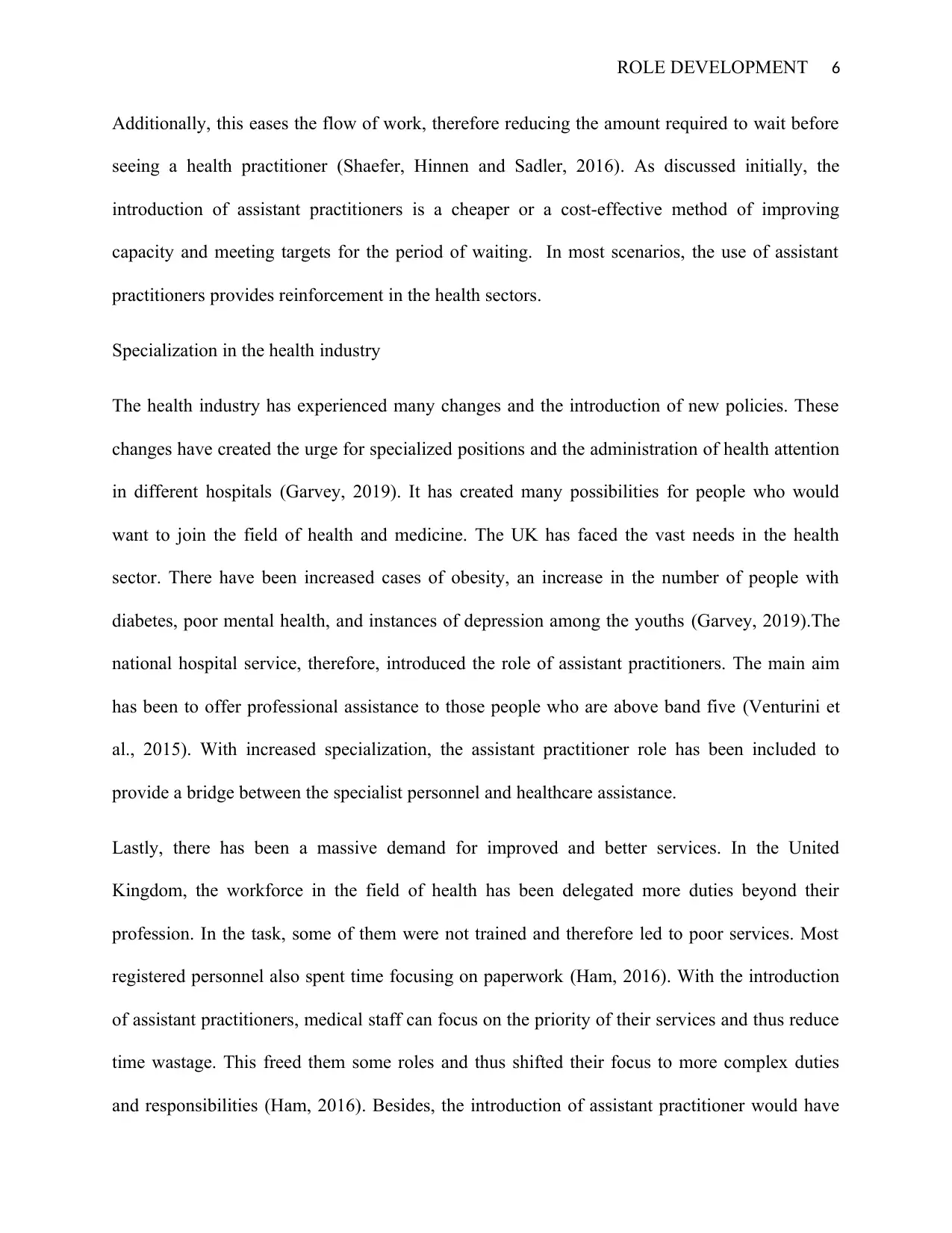
ROLE DEVELOPMENT 6
Additionally, this eases the flow of work, therefore reducing the amount required to wait before
seeing a health practitioner (Shaefer, Hinnen and Sadler, 2016). As discussed initially, the
introduction of assistant practitioners is a cheaper or a cost-effective method of improving
capacity and meeting targets for the period of waiting. In most scenarios, the use of assistant
practitioners provides reinforcement in the health sectors.
Specialization in the health industry
The health industry has experienced many changes and the introduction of new policies. These
changes have created the urge for specialized positions and the administration of health attention
in different hospitals (Garvey, 2019). It has created many possibilities for people who would
want to join the field of health and medicine. The UK has faced the vast needs in the health
sector. There have been increased cases of obesity, an increase in the number of people with
diabetes, poor mental health, and instances of depression among the youths (Garvey, 2019).The
national hospital service, therefore, introduced the role of assistant practitioners. The main aim
has been to offer professional assistance to those people who are above band five (Venturini et
al., 2015). With increased specialization, the assistant practitioner role has been included to
provide a bridge between the specialist personnel and healthcare assistance.
Lastly, there has been a massive demand for improved and better services. In the United
Kingdom, the workforce in the field of health has been delegated more duties beyond their
profession. In the task, some of them were not trained and therefore led to poor services. Most
registered personnel also spent time focusing on paperwork (Ham, 2016). With the introduction
of assistant practitioners, medical staff can focus on the priority of their services and thus reduce
time wastage. This freed them some roles and thus shifted their focus to more complex duties
and responsibilities (Ham, 2016). Besides, the introduction of assistant practitioner would have
Additionally, this eases the flow of work, therefore reducing the amount required to wait before
seeing a health practitioner (Shaefer, Hinnen and Sadler, 2016). As discussed initially, the
introduction of assistant practitioners is a cheaper or a cost-effective method of improving
capacity and meeting targets for the period of waiting. In most scenarios, the use of assistant
practitioners provides reinforcement in the health sectors.
Specialization in the health industry
The health industry has experienced many changes and the introduction of new policies. These
changes have created the urge for specialized positions and the administration of health attention
in different hospitals (Garvey, 2019). It has created many possibilities for people who would
want to join the field of health and medicine. The UK has faced the vast needs in the health
sector. There have been increased cases of obesity, an increase in the number of people with
diabetes, poor mental health, and instances of depression among the youths (Garvey, 2019).The
national hospital service, therefore, introduced the role of assistant practitioners. The main aim
has been to offer professional assistance to those people who are above band five (Venturini et
al., 2015). With increased specialization, the assistant practitioner role has been included to
provide a bridge between the specialist personnel and healthcare assistance.
Lastly, there has been a massive demand for improved and better services. In the United
Kingdom, the workforce in the field of health has been delegated more duties beyond their
profession. In the task, some of them were not trained and therefore led to poor services. Most
registered personnel also spent time focusing on paperwork (Ham, 2016). With the introduction
of assistant practitioners, medical staff can focus on the priority of their services and thus reduce
time wastage. This freed them some roles and thus shifted their focus to more complex duties
and responsibilities (Ham, 2016). Besides, the introduction of assistant practitioner would have
⊘ This is a preview!⊘
Do you want full access?
Subscribe today to unlock all pages.

Trusted by 1+ million students worldwide
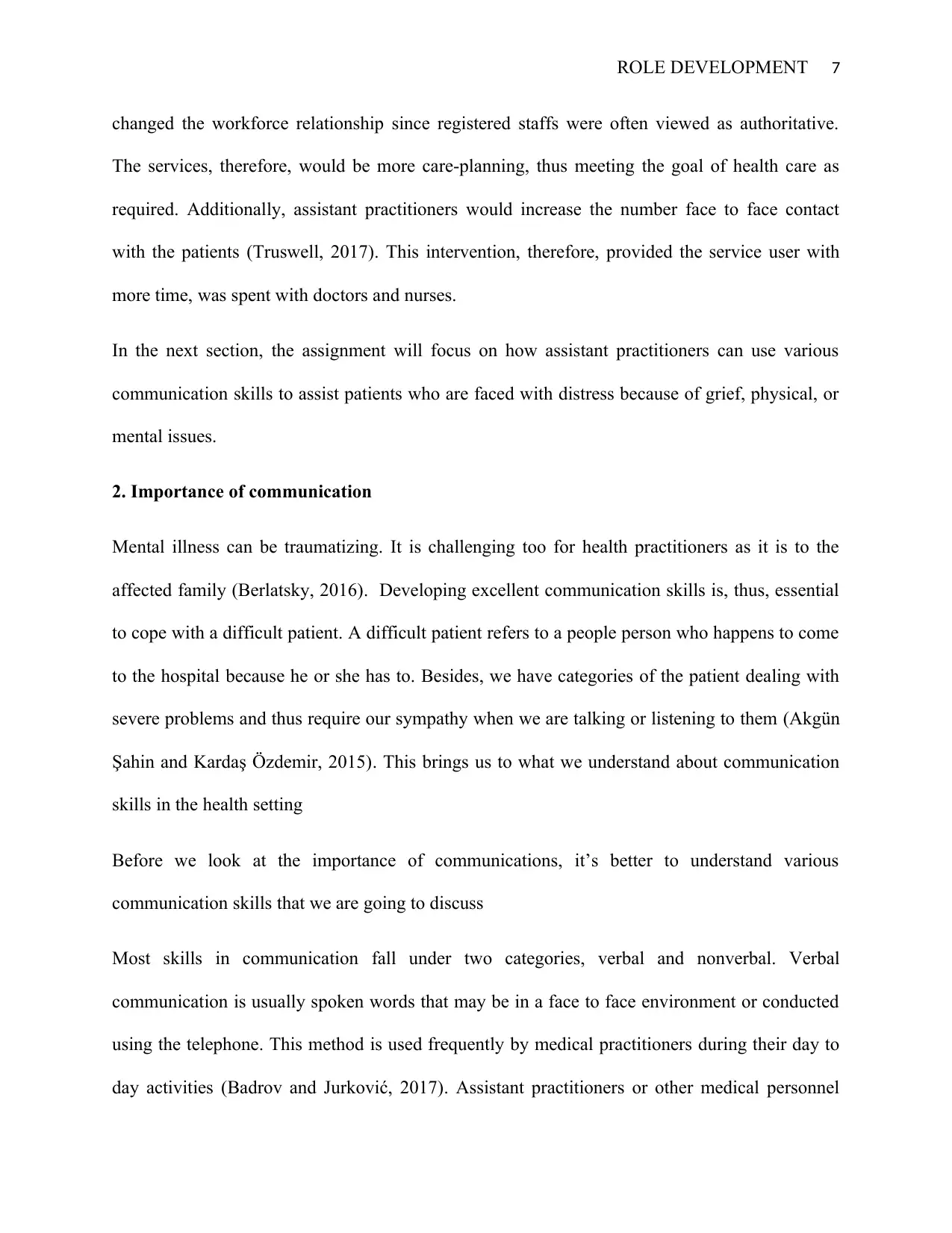
ROLE DEVELOPMENT 7
changed the workforce relationship since registered staffs were often viewed as authoritative.
The services, therefore, would be more care-planning, thus meeting the goal of health care as
required. Additionally, assistant practitioners would increase the number face to face contact
with the patients (Truswell, 2017). This intervention, therefore, provided the service user with
more time, was spent with doctors and nurses.
In the next section, the assignment will focus on how assistant practitioners can use various
communication skills to assist patients who are faced with distress because of grief, physical, or
mental issues.
2. Importance of communication
Mental illness can be traumatizing. It is challenging too for health practitioners as it is to the
affected family (Berlatsky, 2016). Developing excellent communication skills is, thus, essential
to cope with a difficult patient. A difficult patient refers to a people person who happens to come
to the hospital because he or she has to. Besides, we have categories of the patient dealing with
severe problems and thus require our sympathy when we are talking or listening to them (Akgün
Şahin and Kardaş Özdemir, 2015). This brings us to what we understand about communication
skills in the health setting
Before we look at the importance of communications, it’s better to understand various
communication skills that we are going to discuss
Most skills in communication fall under two categories, verbal and nonverbal. Verbal
communication is usually spoken words that may be in a face to face environment or conducted
using the telephone. This method is used frequently by medical practitioners during their day to
day activities (Badrov and Jurković, 2017). Assistant practitioners or other medical personnel
changed the workforce relationship since registered staffs were often viewed as authoritative.
The services, therefore, would be more care-planning, thus meeting the goal of health care as
required. Additionally, assistant practitioners would increase the number face to face contact
with the patients (Truswell, 2017). This intervention, therefore, provided the service user with
more time, was spent with doctors and nurses.
In the next section, the assignment will focus on how assistant practitioners can use various
communication skills to assist patients who are faced with distress because of grief, physical, or
mental issues.
2. Importance of communication
Mental illness can be traumatizing. It is challenging too for health practitioners as it is to the
affected family (Berlatsky, 2016). Developing excellent communication skills is, thus, essential
to cope with a difficult patient. A difficult patient refers to a people person who happens to come
to the hospital because he or she has to. Besides, we have categories of the patient dealing with
severe problems and thus require our sympathy when we are talking or listening to them (Akgün
Şahin and Kardaş Özdemir, 2015). This brings us to what we understand about communication
skills in the health setting
Before we look at the importance of communications, it’s better to understand various
communication skills that we are going to discuss
Most skills in communication fall under two categories, verbal and nonverbal. Verbal
communication is usually spoken words that may be in a face to face environment or conducted
using the telephone. This method is used frequently by medical practitioners during their day to
day activities (Badrov and Jurković, 2017). Assistant practitioners or other medical personnel
Paraphrase This Document
Need a fresh take? Get an instant paraphrase of this document with our AI Paraphraser

ROLE DEVELOPMENT 8
may use verbal communication to avail information to physically and mentally distress patients.
It may also be used to reassure the patient. Additionally, the patient may respond by providing
more details, thus giving a practitioner the chance to understand her concerns.
The questioning largely dominates verbal communication. This is because it allows medical
personnel to gather more information. Either open or closed questions may be applied in various
settings. Closed questions in the hospital require a yes or no response. This allows for a shorter
time to acquire the necessary information. Open questions are used to encourage the patient to
play a significant role in explaining his or her problem. It also creates a ground in which both
the medical practitioner and the patients can discuss the means of treatment available.
Apart from talking, communication also involves listening skills. Assistant practitioners and
nurses may use these vital skills to convey information regarding patient health conventionally.
Through listening, the nurse or associate practitioner responds to the patient's concerns,
especially on care and treatment (Hofert et al., 2015). These skills dictate the outcome of any
emergency attention. Being focused on the patients and taking in mind what they are trying to
say is one of the essential aspects of any assistant practitioner
A non-verbal communication skill doesn’t involve the use of words when communicating. It
conveys attitude and our feeling toward another person. It is what we say using our body's
reaction, gestures, facial expressions, touches, mode of dressing, our gaze, body space, and
posture. The purpose of having this skill to any assistant practitioner is that nonverbal
communication reinforces verbal communication. The medical practitioners should not focus on
what they're saying but how they are reacting while they're giving information. Most patients can
detect signs of interest or disinterest from medical practitioners' behaviors (Hofert et al., 2015).
The most common method used in nursing to show attention and attentiveness is SOLER.
may use verbal communication to avail information to physically and mentally distress patients.
It may also be used to reassure the patient. Additionally, the patient may respond by providing
more details, thus giving a practitioner the chance to understand her concerns.
The questioning largely dominates verbal communication. This is because it allows medical
personnel to gather more information. Either open or closed questions may be applied in various
settings. Closed questions in the hospital require a yes or no response. This allows for a shorter
time to acquire the necessary information. Open questions are used to encourage the patient to
play a significant role in explaining his or her problem. It also creates a ground in which both
the medical practitioner and the patients can discuss the means of treatment available.
Apart from talking, communication also involves listening skills. Assistant practitioners and
nurses may use these vital skills to convey information regarding patient health conventionally.
Through listening, the nurse or associate practitioner responds to the patient's concerns,
especially on care and treatment (Hofert et al., 2015). These skills dictate the outcome of any
emergency attention. Being focused on the patients and taking in mind what they are trying to
say is one of the essential aspects of any assistant practitioner
A non-verbal communication skill doesn’t involve the use of words when communicating. It
conveys attitude and our feeling toward another person. It is what we say using our body's
reaction, gestures, facial expressions, touches, mode of dressing, our gaze, body space, and
posture. The purpose of having this skill to any assistant practitioner is that nonverbal
communication reinforces verbal communication. The medical practitioners should not focus on
what they're saying but how they are reacting while they're giving information. Most patients can
detect signs of interest or disinterest from medical practitioners' behaviors (Hofert et al., 2015).
The most common method used in nursing to show attention and attentiveness is SOLER.
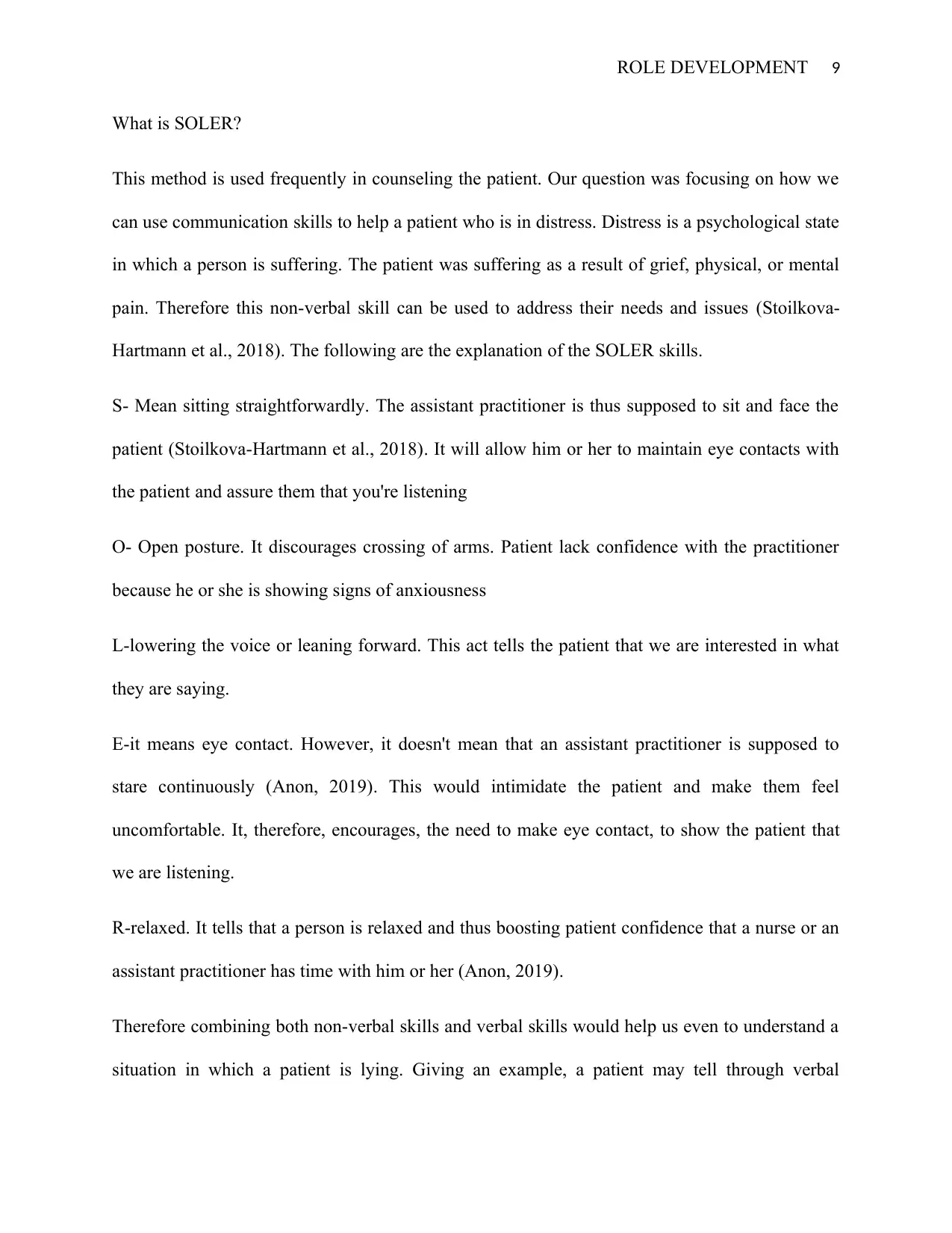
ROLE DEVELOPMENT 9
What is SOLER?
This method is used frequently in counseling the patient. Our question was focusing on how we
can use communication skills to help a patient who is in distress. Distress is a psychological state
in which a person is suffering. The patient was suffering as a result of grief, physical, or mental
pain. Therefore this non-verbal skill can be used to address their needs and issues (Stoilkova-
Hartmann et al., 2018). The following are the explanation of the SOLER skills.
S- Mean sitting straightforwardly. The assistant practitioner is thus supposed to sit and face the
patient (Stoilkova-Hartmann et al., 2018). It will allow him or her to maintain eye contacts with
the patient and assure them that you're listening
O- Open posture. It discourages crossing of arms. Patient lack confidence with the practitioner
because he or she is showing signs of anxiousness
L-lowering the voice or leaning forward. This act tells the patient that we are interested in what
they are saying.
E-it means eye contact. However, it doesn't mean that an assistant practitioner is supposed to
stare continuously (Anon, 2019). This would intimidate the patient and make them feel
uncomfortable. It, therefore, encourages, the need to make eye contact, to show the patient that
we are listening.
R-relaxed. It tells that a person is relaxed and thus boosting patient confidence that a nurse or an
assistant practitioner has time with him or her (Anon, 2019).
Therefore combining both non-verbal skills and verbal skills would help us even to understand a
situation in which a patient is lying. Giving an example, a patient may tell through verbal
What is SOLER?
This method is used frequently in counseling the patient. Our question was focusing on how we
can use communication skills to help a patient who is in distress. Distress is a psychological state
in which a person is suffering. The patient was suffering as a result of grief, physical, or mental
pain. Therefore this non-verbal skill can be used to address their needs and issues (Stoilkova-
Hartmann et al., 2018). The following are the explanation of the SOLER skills.
S- Mean sitting straightforwardly. The assistant practitioner is thus supposed to sit and face the
patient (Stoilkova-Hartmann et al., 2018). It will allow him or her to maintain eye contacts with
the patient and assure them that you're listening
O- Open posture. It discourages crossing of arms. Patient lack confidence with the practitioner
because he or she is showing signs of anxiousness
L-lowering the voice or leaning forward. This act tells the patient that we are interested in what
they are saying.
E-it means eye contact. However, it doesn't mean that an assistant practitioner is supposed to
stare continuously (Anon, 2019). This would intimidate the patient and make them feel
uncomfortable. It, therefore, encourages, the need to make eye contact, to show the patient that
we are listening.
R-relaxed. It tells that a person is relaxed and thus boosting patient confidence that a nurse or an
assistant practitioner has time with him or her (Anon, 2019).
Therefore combining both non-verbal skills and verbal skills would help us even to understand a
situation in which a patient is lying. Giving an example, a patient may tell through verbal
⊘ This is a preview!⊘
Do you want full access?
Subscribe today to unlock all pages.

Trusted by 1+ million students worldwide
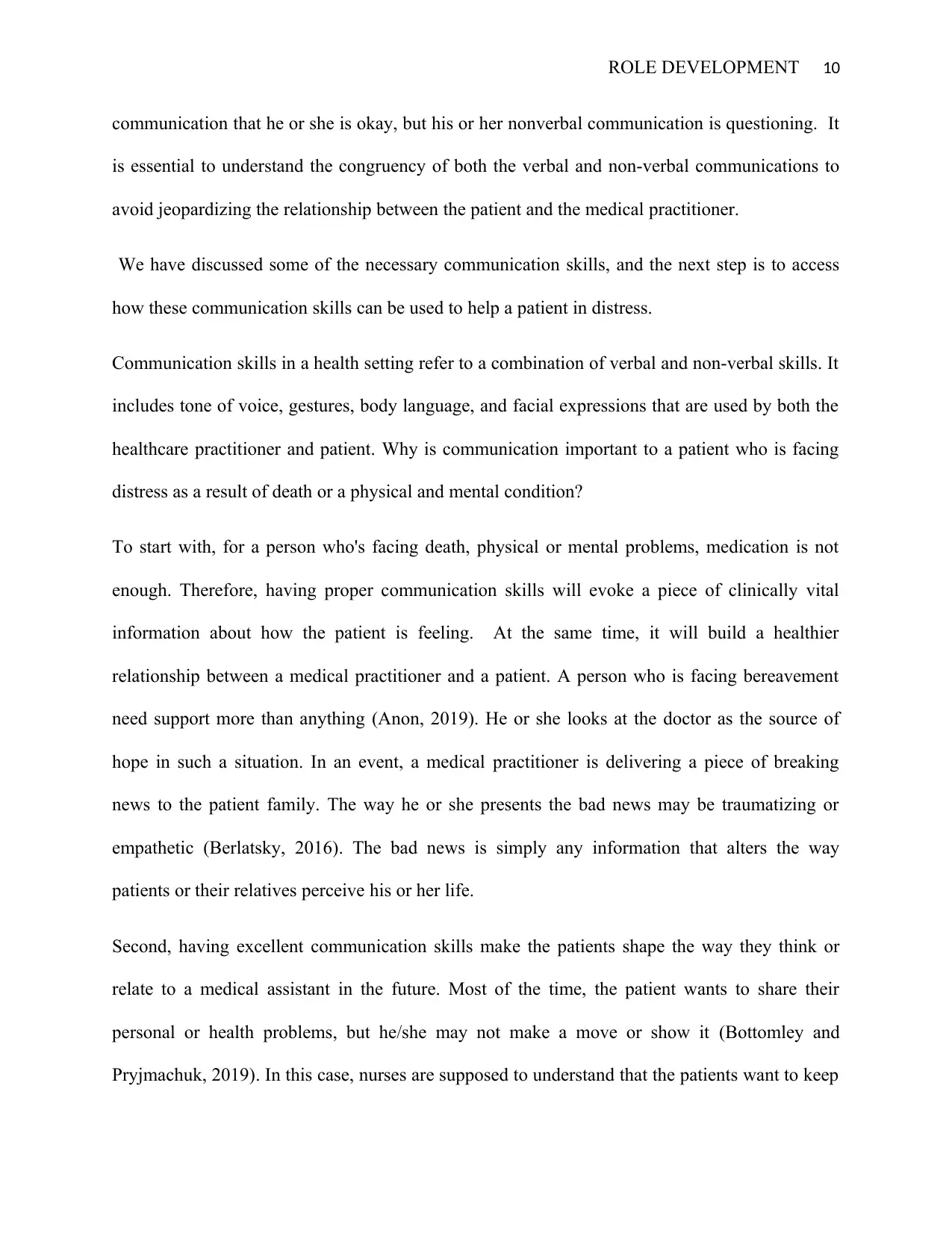
ROLE DEVELOPMENT 10
communication that he or she is okay, but his or her nonverbal communication is questioning. It
is essential to understand the congruency of both the verbal and non-verbal communications to
avoid jeopardizing the relationship between the patient and the medical practitioner.
We have discussed some of the necessary communication skills, and the next step is to access
how these communication skills can be used to help a patient in distress.
Communication skills in a health setting refer to a combination of verbal and non-verbal skills. It
includes tone of voice, gestures, body language, and facial expressions that are used by both the
healthcare practitioner and patient. Why is communication important to a patient who is facing
distress as a result of death or a physical and mental condition?
To start with, for a person who's facing death, physical or mental problems, medication is not
enough. Therefore, having proper communication skills will evoke a piece of clinically vital
information about how the patient is feeling. At the same time, it will build a healthier
relationship between a medical practitioner and a patient. A person who is facing bereavement
need support more than anything (Anon, 2019). He or she looks at the doctor as the source of
hope in such a situation. In an event, a medical practitioner is delivering a piece of breaking
news to the patient family. The way he or she presents the bad news may be traumatizing or
empathetic (Berlatsky, 2016). The bad news is simply any information that alters the way
patients or their relatives perceive his or her life.
Second, having excellent communication skills make the patients shape the way they think or
relate to a medical assistant in the future. Most of the time, the patient wants to share their
personal or health problems, but he/she may not make a move or show it (Bottomley and
Pryjmachuk, 2019). In this case, nurses are supposed to understand that the patients want to keep
communication that he or she is okay, but his or her nonverbal communication is questioning. It
is essential to understand the congruency of both the verbal and non-verbal communications to
avoid jeopardizing the relationship between the patient and the medical practitioner.
We have discussed some of the necessary communication skills, and the next step is to access
how these communication skills can be used to help a patient in distress.
Communication skills in a health setting refer to a combination of verbal and non-verbal skills. It
includes tone of voice, gestures, body language, and facial expressions that are used by both the
healthcare practitioner and patient. Why is communication important to a patient who is facing
distress as a result of death or a physical and mental condition?
To start with, for a person who's facing death, physical or mental problems, medication is not
enough. Therefore, having proper communication skills will evoke a piece of clinically vital
information about how the patient is feeling. At the same time, it will build a healthier
relationship between a medical practitioner and a patient. A person who is facing bereavement
need support more than anything (Anon, 2019). He or she looks at the doctor as the source of
hope in such a situation. In an event, a medical practitioner is delivering a piece of breaking
news to the patient family. The way he or she presents the bad news may be traumatizing or
empathetic (Berlatsky, 2016). The bad news is simply any information that alters the way
patients or their relatives perceive his or her life.
Second, having excellent communication skills make the patients shape the way they think or
relate to a medical assistant in the future. Most of the time, the patient wants to share their
personal or health problems, but he/she may not make a move or show it (Bottomley and
Pryjmachuk, 2019). In this case, nurses are supposed to understand that the patients want to keep
Paraphrase This Document
Need a fresh take? Get an instant paraphrase of this document with our AI Paraphraser

ROLE DEVELOPMENT 11
a shallow conversation and that; in return, they elect a transparent and more straightforward
conversation from medical practitioners. The important thing a nurse can do is to respect the
feelings of a patient (Badrov and Jurković, 2017). Communication skills don't revolve around
giving information and instructions. It also includes having the skills to listen and respond based
on what you heard. Therefore, a medical practitioner who possesses poor listening skills won't be
able to fully comprehend the information that the patient is trying to give (PRICE et al., 2019).
He or she won't be able to respond appropriately, thus resulting in deprived patient attention and
non-adherence to what policies governing the field of medicine and health. Active listening to a
patient who is in a mental state or bereaved will help medical practitioners to avoid missing vital
clues
Bereavement instills emotional pain to families, and it is often traumatizing. Most patients don't
know how to respond to health situations, and most of the time, they are in a stressful situation.
This makes them experience mixed emotions, which, in most cases, are harmful. Therefore,
there's a need to show them compassion by putting yourselves in their shoes and showing them
you understand how they are feeling (Badrov and Jurković, 2017). The way we give information
to patients to some extent, describe the degree of their problem. It’s thus recommended for a
medical practitioner to not only checking on the patient but also to explain we're doing so. For
example, a person who is having a severe wound on the leg would possess the fear of
amputation. Giving them a statement like, "I'll be checking your leg after every 20 minutes",
would make them feel their situation is worse. Fully explaining why the action is being
performed after 20 minutes will ease the tension.
Another essential reason is patients need honesty and frankness. Although the tone used should
be caring, the results must be delivered to the patient. A person who has lost a friend or relative
a shallow conversation and that; in return, they elect a transparent and more straightforward
conversation from medical practitioners. The important thing a nurse can do is to respect the
feelings of a patient (Badrov and Jurković, 2017). Communication skills don't revolve around
giving information and instructions. It also includes having the skills to listen and respond based
on what you heard. Therefore, a medical practitioner who possesses poor listening skills won't be
able to fully comprehend the information that the patient is trying to give (PRICE et al., 2019).
He or she won't be able to respond appropriately, thus resulting in deprived patient attention and
non-adherence to what policies governing the field of medicine and health. Active listening to a
patient who is in a mental state or bereaved will help medical practitioners to avoid missing vital
clues
Bereavement instills emotional pain to families, and it is often traumatizing. Most patients don't
know how to respond to health situations, and most of the time, they are in a stressful situation.
This makes them experience mixed emotions, which, in most cases, are harmful. Therefore,
there's a need to show them compassion by putting yourselves in their shoes and showing them
you understand how they are feeling (Badrov and Jurković, 2017). The way we give information
to patients to some extent, describe the degree of their problem. It’s thus recommended for a
medical practitioner to not only checking on the patient but also to explain we're doing so. For
example, a person who is having a severe wound on the leg would possess the fear of
amputation. Giving them a statement like, "I'll be checking your leg after every 20 minutes",
would make them feel their situation is worse. Fully explaining why the action is being
performed after 20 minutes will ease the tension.
Another essential reason is patients need honesty and frankness. Although the tone used should
be caring, the results must be delivered to the patient. A person who has lost a friend or relative

ROLE DEVELOPMENT 12
must be handed the bad news (Bottomley and Pryjmachuk, 2019). However, it is the tone that
will affect them. Considering etiquettes like I'm sorry we tried but, he didn't make it. The
information is honest and precise; it also shows sympathy and that the health practitioner is
concerned.
Lastly, essential communication skills can help the nurse to respond to different cultural and age
appropriateness scenarios. Some cultures are different from one another. Patients came from all
the walk of life. Therefore there's the need to possess skills to listen, understand, and engage in
discussions and matters that allow consideration of other people's beliefs, ideals, and values. One
of the main aims of communication is to convey respect. Therefore, a practitioner will be able to
respect a patient's right in medication or advice. But for the most patients who are mentally or
physically distressed, I believe having compassion will make them understand their situation
better
We have discussed the importance of communication skills in caring for patients. We can look
at the benefit assistant practitioner have brought in the field of health through skills and
knowledge to other health workers
3. Contribution of the Assistant Practitioner in the growth of knowledge and skills of other
staff
As discussed initially, numerous United Kingdom hospitals have experienced a shortage in the
number of nurses (Manton and Springer International Publishing Ag, 2019). Therefore, many
organizations had to access and look for the support of assistant practitioners and use their ability
to assist in the health centers. Most assistant practitioners work at Band 4, where there are more
skills and knowledge required (Meertens, 2016). This enables them to offer care and needs
must be handed the bad news (Bottomley and Pryjmachuk, 2019). However, it is the tone that
will affect them. Considering etiquettes like I'm sorry we tried but, he didn't make it. The
information is honest and precise; it also shows sympathy and that the health practitioner is
concerned.
Lastly, essential communication skills can help the nurse to respond to different cultural and age
appropriateness scenarios. Some cultures are different from one another. Patients came from all
the walk of life. Therefore there's the need to possess skills to listen, understand, and engage in
discussions and matters that allow consideration of other people's beliefs, ideals, and values. One
of the main aims of communication is to convey respect. Therefore, a practitioner will be able to
respect a patient's right in medication or advice. But for the most patients who are mentally or
physically distressed, I believe having compassion will make them understand their situation
better
We have discussed the importance of communication skills in caring for patients. We can look
at the benefit assistant practitioner have brought in the field of health through skills and
knowledge to other health workers
3. Contribution of the Assistant Practitioner in the growth of knowledge and skills of other
staff
As discussed initially, numerous United Kingdom hospitals have experienced a shortage in the
number of nurses (Manton and Springer International Publishing Ag, 2019). Therefore, many
organizations had to access and look for the support of assistant practitioners and use their ability
to assist in the health centers. Most assistant practitioners work at Band 4, where there are more
skills and knowledge required (Meertens, 2016). This enables them to offer care and needs
⊘ This is a preview!⊘
Do you want full access?
Subscribe today to unlock all pages.

Trusted by 1+ million students worldwide
1 out of 21
Related Documents
Your All-in-One AI-Powered Toolkit for Academic Success.
+13062052269
info@desklib.com
Available 24*7 on WhatsApp / Email
![[object Object]](/_next/static/media/star-bottom.7253800d.svg)
Unlock your academic potential
Copyright © 2020–2025 A2Z Services. All Rights Reserved. Developed and managed by ZUCOL.





